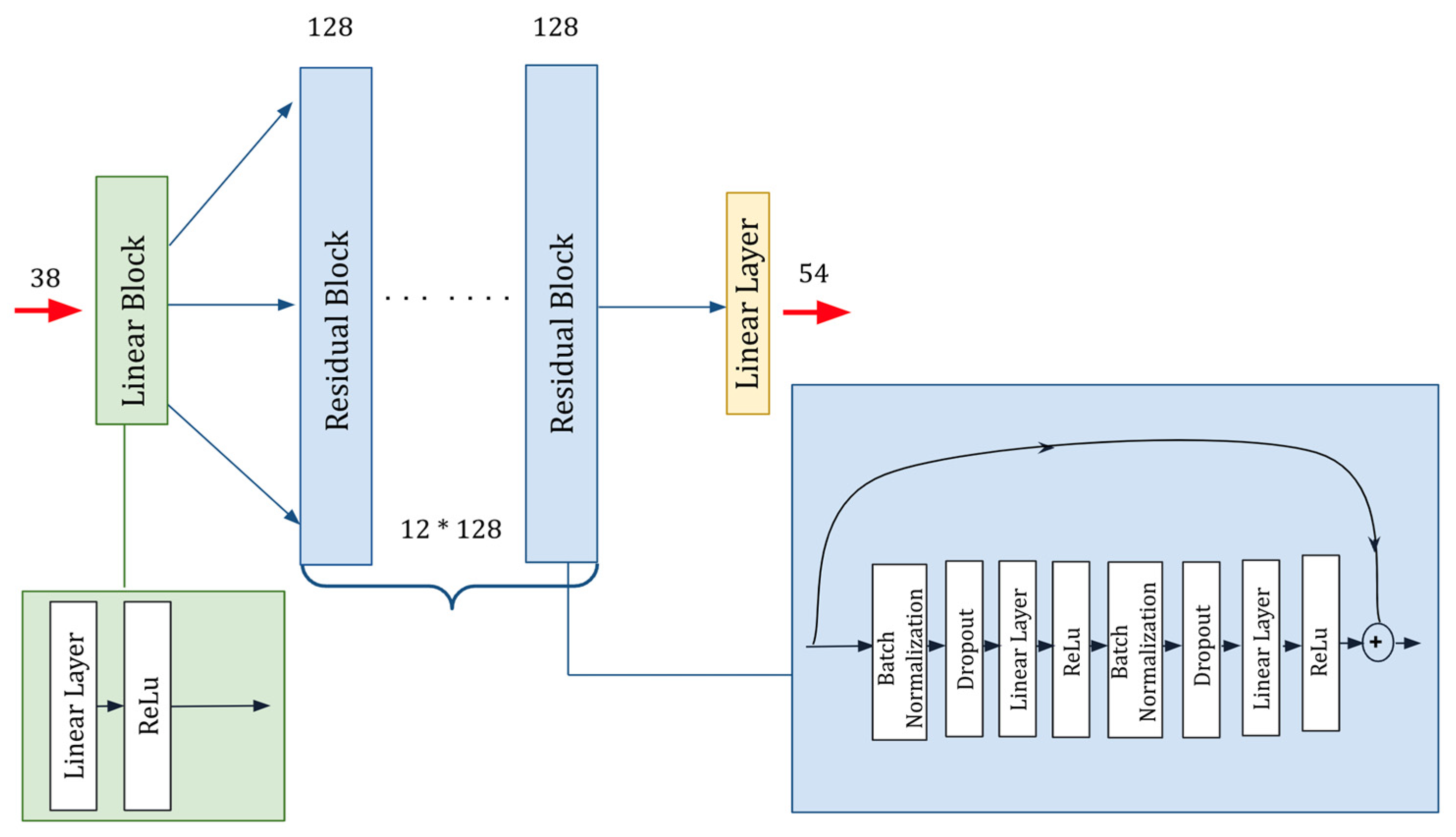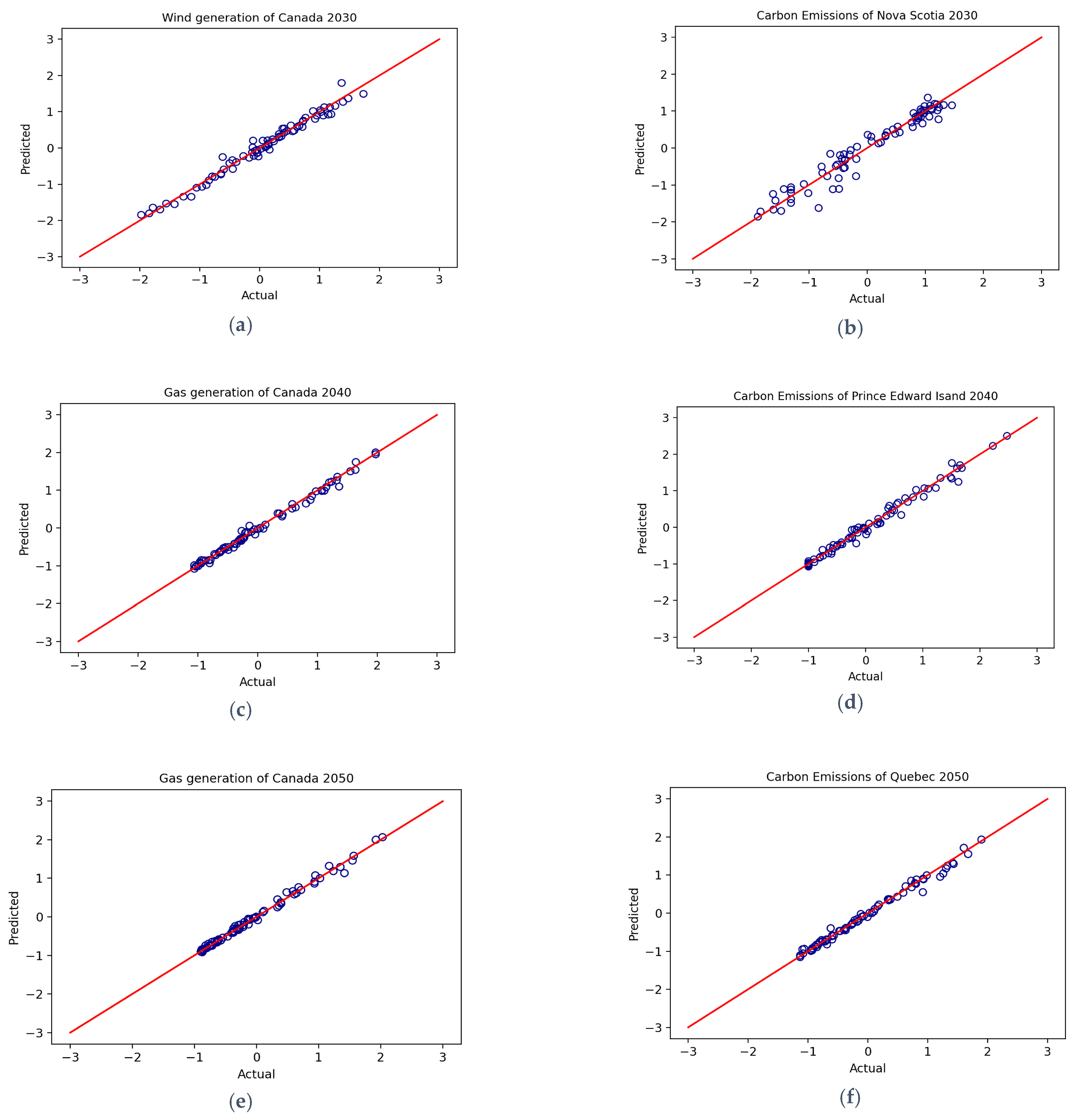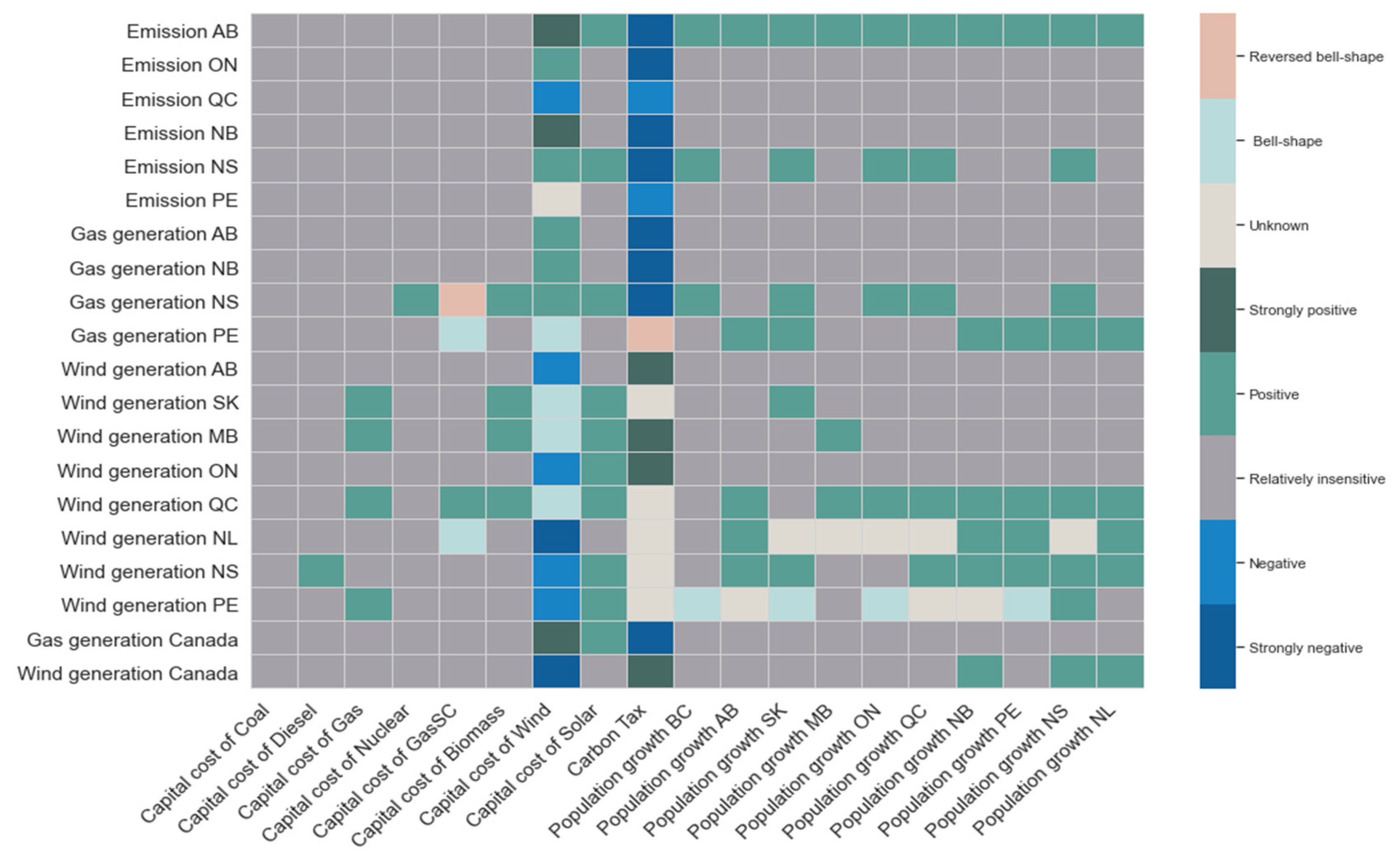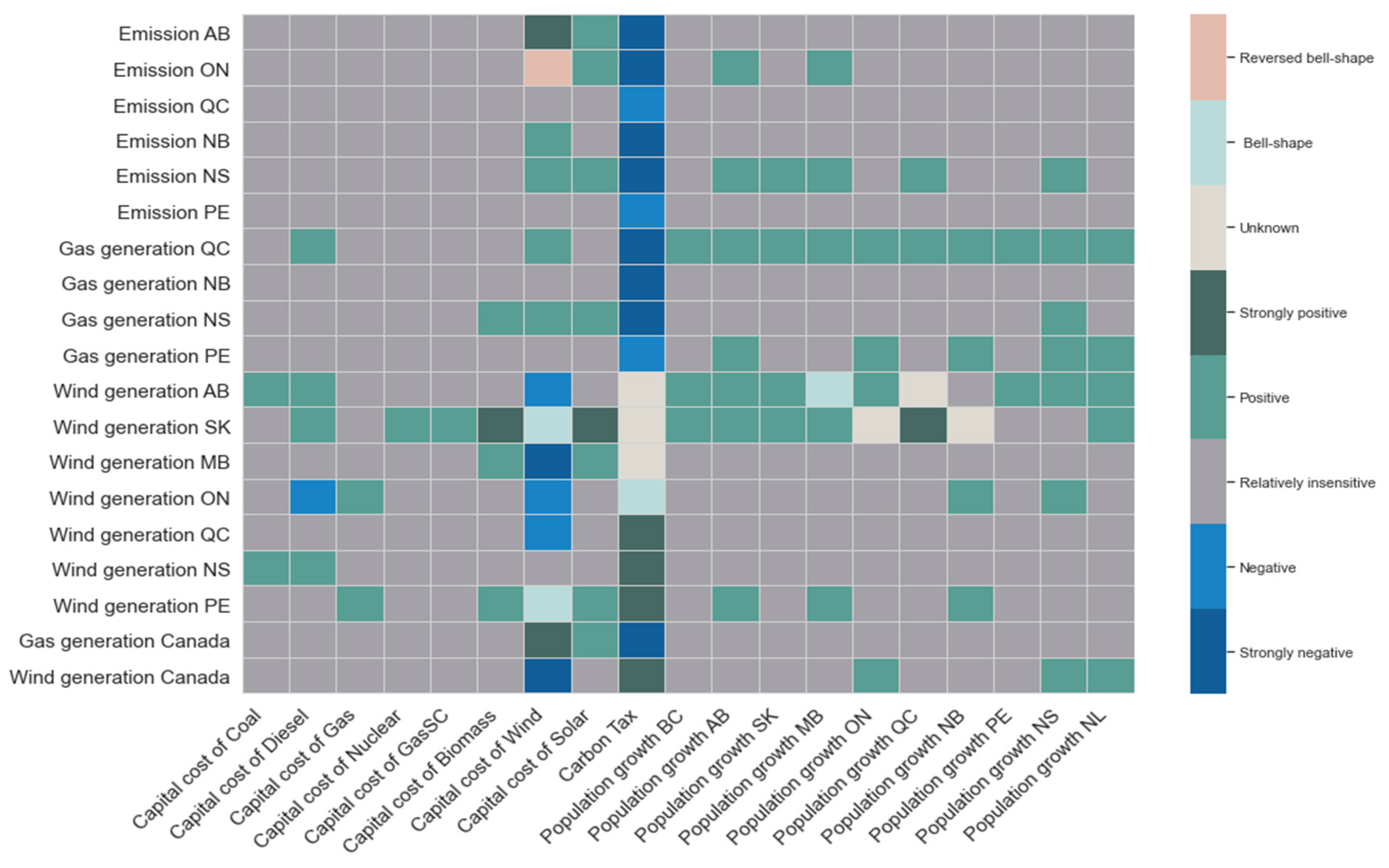A Deep Learning Approach for Exploring the Design Space for the Decarbonization of the Canadian Electricity System
Abstract
1. Introduction
1.1. Modelling the Energy System Transition
- Facilitates the development of robust, well-supported policy options, including identification of the most critical policy-planning inputs.
- Provides insights into critical relationships within the energy system design space that would have been previously inaccessible using conventional ESMs, altering the nature of decarbonization conversations, and allowing for large-scale and impact-ranked policy assessment.
1.2. Literature Review
Machine Learning for Energy Systems Analysis
1.3. Objectives and Contributions
- To develop a computationally efficient ESM to investigate complex relationships within the Canadian electricity system.
- To leverage the expanded functionality of this modelling approach to produce high-impact insights into key drivers of Canada’s decarbonization pathways.
- We propose a pipeline that utilizes ML methods to reduce the computational burden of a capacity expansion model at a national level by 5 orders of magnitude, with a mean R-squared value of 0.93. Utilizing this tool, we investigate the complex interdependency of factors involved in large-scale energy systems and the efficacy of sustainable energy policies.
- Using this model, we identify key variables affecting power systems and provide sensitivity measures leading to a more robust analysis.
- We implement an easy-to-interpret method utilizing an unsupervised ML method and comparative maps, allowing for the effective conveyance of results to stakeholders.
- We compare the outputs’ behavior to changes in all inputs. The impact of all inputs on specific outputs is evaluated with a quantitative metric.
- The results of this study contribute a huge number of insights into Canada’s electricity system development, some of which are further explored and understood through advanced visualizations.
2. Materials and Methods
2.1. Electricity System Capacity Expansion Modelling Using COPPER
2.2. Surrogate Model Development with Deep Neural Networks
2.3. COPPER Surrogate Model Development
2.3.1. Data Generation
2.3.2. Data Preparation
2.3.3. Model Training
2.3.4. Ablation Study to Determine Model Architecture
2.4. Exploring Correlations in the Design Space
- Clustering and mapping input-output relationships onto heat maps to provide qualitative depictions of the strength of each correlation.
- Charting the normalized maximum derivatives of two key outputs in each time step with respect to each input as a supplementary indicator showing the relative quantified impact of all inputs on a target output.
2.4.1. Clustering and Dimensionality Reduction of the Results:
2.4.2. Relative Impact of Policy Parameters
3. Results
3.1. COPPER Surrogate Model Performance
3.1.1. Model Evaluation
3.1.2. Computational Cost Evaluation
3.1.3. Limitations of Machine Learning Models for Surrogate Energy Systems Analysis
3.1.4. Limitations Relative to COPPER for Policymakers
3.2. Key Relationships in Canada’s Electricity System Design Space
3.2.1. Correlations between Inputs, and Emissions and Generation Output
3.2.2. Ranking of Factors Affecting Gas and Wind Capacity Development
4. Discussion
4.1. Demand Growth Effects
4.2. Capital Cost Effects
4.3. System Sensitivity over Time
5. Conclusions
Future Work
Author Contributions
Funding
Data Availability Statement
Acknowledgments
Conflicts of Interest
Abbreviations
| Symbol | Definition |
| AB | Alberta |
| BC | British Columbia |
| SK | Saskatchewan |
| MB | Manitoba |
| ON | Ontario |
| QC | Quebec |
| NB | New Brunswick |
| PE | Prince Edward Island |
| NS | Nova Scotia |
| NL | Newfound land and Labrador |
References
- Sixth Assessment Report—IPCC. Available online: https://www.ipcc.ch/assessment-report/ar6/ (accessed on 19 December 2022).
- Rissman, J.; Bataille, C.; Masanet, E.; Aden, N.; Morrow, W.R.; Zhou, N.; Elliott, N.; Dell, R.; Heeren, N.; Huckestein, B.; et al. Technologies and policies to decarbonize global industry: Review and assessment of mitigation drivers through 2070. Appl. Energy 2020, 266, 114848. [Google Scholar] [CrossRef]
- Abdullah, L.; Najib, L. Sustainable energy planning decision using the intuitionistic fuzzy analytic hierarchy process: Choosing energy technology in Malaysia. Int. J. Sustain. Energy 2016, 35, 360–377. [Google Scholar] [CrossRef]
- Karunathilake, H.; Hewage, K.; Mérida, W.; Sadiq, R. Renewable energy selection for net-zero energy communities: Life cycle based decision making under uncertainty. Renew Energy 2019, 130, 558–573. [Google Scholar] [CrossRef]
- Solangi, Y.A.; Tan, Q.; Mirjat, N.H.; Ali, S. Evaluating the strategies for sustainable energy planning in Pakistan: An integrated SWOT-AHP and Fuzzy-TOPSIS approach. J. Clean. Prod. 2019, 236, 117655. [Google Scholar] [CrossRef]
- Nguyen, Q.K. Long Term Optimization of Energy Supply and Demand in Vietnam with Special Reference to the Potential of Renewable Energy. Doctoral Dissertation, Universität Oldenburg, Oldenburg, Germany, 2005. [Google Scholar]
- Mosavi, A.; Salimi, M.; Ardabili, S.F.; Rabczuk, T.; Shamshirband, S.; Varkonyi-Koczy, A.R. State of the art of machine learning models in energy systems, a systematic review. Energies 2019, 12, 1301. [Google Scholar] [CrossRef]
- Arjmand, R.; McPherson, M. Canada’s electricity system transition under alternative policy scenarios. Energy Policy 2022, 163, 112844. [Google Scholar] [CrossRef]
- Westermann, P.; Evins, R. Surrogate modelling for sustainable building design—A review. Energy Build. 2019, 198, 170–186. [Google Scholar] [CrossRef]
- Pour, P.A.; Rodemann, T.; Hakanen, J.; Miettinen, K. Surrogate assisted interactive multiobjective optimization in energy system design of buildings. Optim. Eng. 2022, 23, 303–327. [Google Scholar] [CrossRef]
- Westermann, P.; Evins, R. Using Bayesian deep learning approaches for uncertainty-aware building energy surrogate models. Energy AI 2021, 3, 100039. [Google Scholar] [CrossRef]
- Dreiseitl, S.; Ohno-Machado, L. Logistic regression and artificial neural network classification models: A methodology review. J. Biomed. Inform. 2002, 35, 352–359. [Google Scholar] [CrossRef]
- Fraley, C.; Raftery, A.E. How Many Clusters? Which Clustering Method? Answers Via Model-Based Cluster Analysis. Comput. J. 1998, 41, 578–588. [Google Scholar] [CrossRef]
- Ben-Gal, I. Outlier Detection. In Data Mining and Knowledge Discovery Handbook; Springer: Berlin/Heidelberg, Germany, 2005; pp. 131–146. [Google Scholar] [CrossRef]
- Ahmad, T.; Chen, H. A review on machine learning forecasting growth trends and their real-time applications in different energy systems. Sustain. Cities Soc. 2020, 54, 102010. [Google Scholar] [CrossRef]
- Arikan, Ç.; Özdemir, M.; Üniversitesi, Y.T.; Üniversitesi, M. Classification of Power Quality Disturbances at Power System Frequency and out of Power System Frequency Using Support Vector Machines. Prz. Elektrotech. 2013, 89, 284–291. [Google Scholar]
- Li, X.; Bowers, C.P.; Schnier, T. Classification of Energy Consumption in Buildings With Outlier Detection. IEEE Trans. Ind. Electron. 2010, 57, 3639–3644. [Google Scholar] [CrossRef]
- Habib, U.; Hayat, K.; Zucker, G. Complex building’s energy system operation patterns analysis using bag of words representation with hierarchical clustering. Complex Adapt. Syst. Model. 2016, 4, 8. [Google Scholar] [CrossRef]
- Zhang, G. Surrogate Modelling for Multi-Carrier Distribution Networks. 2021. Available online: https://repository.tudelft.nl/islandora/object/uuid%3A9a65a8f5-7e1c-4b51-a1ce-ff65880ed735 (accessed on 6 August 2021).
- Sciazko, A. Surrogate Modeling Techniques Applied to Energy Systems. 2011. Available online: https://skemman.is/handle/1946/7764 (accessed on 6 August 2021).
- Kim, J.H.; Seong, N.C.; Choi, W. Forecasting the Energy Consumption of an Actual Air Handling Unit and Absorption Chiller Using ANN Models. Energies 2020, 13, 4361. [Google Scholar] [CrossRef]
- Uselis, A.; Lukoševičius, M.; Stasytis, L. Localized Convolutional Neural Networks for Geospatial Wind Forecasting. Energies 2020, 13, 3440. [Google Scholar] [CrossRef]
- Harrison-Atlas, D.; Maclaurin, G.; Lantz, E. Spatially-Explicit Prediction of Capacity Density Advances Geographic Characterization of Wind Power Technical Potential. Energies 2021, 14, 3609. [Google Scholar] [CrossRef]
- Antonopoulos, I.; Robu, V.; Couraud, B.; Kirli, D.; Norbu, S.; Kiprakis, A.; Flynn, D.; Elizondo-Gonzalez, S.; Wattam, S. Artificial intelligence and machine learning approaches to energy demand-side response: A systematic review. Renew. Sustain. Energy Rev. 2020, 130, 10989. [Google Scholar] [CrossRef]
- Li, D.; Yang, D.; Li, L.; Wang, L.; Wang, K. Electrochemical Impedance Spectroscopy Based on the State of Health Estimation for Lithium-Ion Batteries. Energies 2022, 15, 6665. [Google Scholar] [CrossRef]
- Dayhoff, J.E. Neural Network Architectures: An Introduction; Van Nostrand Reinhold Company: Washington, DC, USA, 1990; p. 259. [Google Scholar]
- Bishop, C.M. Neural networks and their applications. Rev. Sci. Instrum. 1994, 65, 1803–1832. [Google Scholar] [CrossRef]
- Schmidhuber, J. Deep Learning in neural networks: An overview. Neural Netw. 2015, 61, 85–117. [Google Scholar] [CrossRef] [PubMed]
- Mosavi, A.; Ardabili, S.; Várkonyi-Kóczy, A.R. List of Deep Learning Models. Lect. Notes Netw. Syst. 2019, 101, 202–214. [Google Scholar] [CrossRef]
- He, K.; Zhang, X.; Ren, S.; Sun, J. Deep Residual Learning for Image Recognition. 2016. Available online: http://image-net.org/challenges/LSVRC/2015/ (accessed on 9 June 2021).
- Dolter, B.; Rivers, N. The cost of decarbonizing the Canadian electricity system. Energy Policy 2018, 113, 135–148. [Google Scholar] [CrossRef]
- A Healthy Environment and a Healthy Economy—Canada.ca. Available online: https://www.canada.ca/en/environment-climate-change/news/2020/12/a-healthy-environment-and-a-healthy-economy.html (accessed on 21 December 2022).
- PyTorch Lightning. Available online: https://www.pytorchlightning.ai/ (accessed on 29 December 2022).
- Srivastava, N.; Hinton, G.; Krizhevsky, A.; Sutskever, I.; Salakhutdinov, R. Dropout: A Simple Way to Prevent Neural Networks from Overfitting. J. Mach. Learn. Res. 2014, 15, 1929–1958. Available online: http://jmlr.org/papers/v15/srivastava14a.html (accessed on 29 December 2022).
- van der Maaten, L.; Hinton, G. Visualizing Data using t-SNE. J. Mach. Learn. Res. 2008, 9, 2579–2605. [Google Scholar]
- Canada, Update to the Pan-Canadian Approach to Carbon Pollution Pricing 2023–2030. 2023. Available online: https://www.canada.ca/en/environment-climate-change/services/climate-change/pricing-pollution-how-it-will-work/carbon-pollution-pricing-federal-benchmark-information/federal-benchmark-2023-2030.html#toc3 (accessed on 15 November 2022).








| Input Variable | Range | Unit |
|---|---|---|
| Carbon tax | 50–750 | $/ton |
| Total demand growth 2050/2018 | 1.4–2.8 | Ratio |
| Annualized capital cost of natural gas | 106.687–130.396 | $/kW |
| Annualized capital cost of diesel | 159.148–194.514 | $/kW |
| Annualized capital cost of coal | 449.183–549.00 | $/kW |
| Annualized capital cost of nuclear | 795.514–972.295 | $/kW |
| Annualized capital of cost biomass (waste) | 465.161–568.531 | $/kW |
| Annualized capital cost of gas simple cycle (gasSC) | 83.478–102.029 | $/kW |
| Annualized capital cost of wind | 119.447–167.226 | $/kW |
| Annualized capital cost of solar | 85.602–142.670 | $/kW |
| Architecture | Training Error (MSE Loss) | Test Error (MSE Loss) |
|---|---|---|
| 1 linear + 12 Residual blocks, Neurons per block = 128, Dropout ratio = 0.5 Batch size = 128, Learning rate = 0.001 | 0.010 | 0.049 |
| 1 linear + 13 Residual blocks, Neurons per block = 128, Dropout ratio = 0.5 Batch size = 128, Learning rate = 0.001 | 0.018 | 0.06 |
| 9 linear blocks, Neurons per block = 128, Dropout ratio = 0.5 Batch size = 128, Learning rate = 0.001 | 0.012 | 0.08 |
| 10 linear blocks, Neurons per block = 128, Dropout ratio = 0.5 Batch size = 128, Learning rate = 0.001 | 0.02 | 0.09 |
| 1 linear + 12 Residual blocks, Neurons per block = 128, Dropout ratio = 0 Batch size = 128, Learning rate = 0.001 | 0.05 | 0.1 |
| 1 linear + 12 Residual blocks, Neurons per block = 128, Dropout ratio = 0.5 Batch size = 128, Learning rate = 0.001 | 0.04 | 0.09 |
| 1 linear + 12 Residual blocks, Neurons per block = 512, Dropout ratio = 0.5 Batch size = 128, Learning rate = 0.0001 | 0.03 | 0.1 |
| 1 linear + 12 Residual blocks, Neurons per block = 512, Dropout ratio = 0.5 Batch size = 128, Learning rate = 0.01 | 0.06 | 0.09 |
| Architecture |
|---|
| 1 linear + 12 Residual blocks Neurons per block = 128 Dropout ratio = 0.5 Batch size = 128 Learning rate = 0.001 25,000 steps (2000 epochs) |
| Shape | Sample Plot | Interpretation |
|---|---|---|
| Negative |  | The output will decrease with the selected input. |
| Strongly negative |  | The output will rapidly decrease with the selected input. |
| Relatively insensitive |  | The output’s variation with respect to the input is not significant relative to its variation with respect to other inputs. Note that these values are normalized, so this does not necessarily imply there is a constant relationship. |
| Positive |  | The output will increase with the selected input. |
| Strongly positive |  | The output will rapidly increase with the selected input. |
| Inconclusive (unknown) |  | There is no identifiable pattern in the correlation between the input and the output. |
| Bell-shaped |  | The output increases, peaks, and then decreases with respect to the input. |
| Inverse bell-shaped |  | The output decreases, reaches a trough, and then increases with respect to the input. |
| Training Loss | Validation Loss | Test Loss | Mean R-Squared | R-Squared Standard Deviation |
|---|---|---|---|---|
| 0.01 | 0.047 | 0.049 | 0.93 | 0.05 |
| Model | CPU | Memory | Run-Time |
|---|---|---|---|
| COPPER | 16–32 | 64–128 GB | 11 h–72 h |
| Residual neural network | 1 | NA * | 17.1 ms |
Disclaimer/Publisher’s Note: The statements, opinions and data contained in all publications are solely those of the individual author(s) and contributor(s) and not of MDPI and/or the editor(s). MDPI and/or the editor(s) disclaim responsibility for any injury to people or property resulting from any ideas, methods, instructions or products referred to in the content. |
© 2023 by the authors. Licensee MDPI, Basel, Switzerland. This article is an open access article distributed under the terms and conditions of the Creative Commons Attribution (CC BY) license (https://creativecommons.org/licenses/by/4.0/).
Share and Cite
Jahangiri, Z.; Judson, M.; Yi, K.M.; McPherson, M. A Deep Learning Approach for Exploring the Design Space for the Decarbonization of the Canadian Electricity System. Energies 2023, 16, 1352. https://doi.org/10.3390/en16031352
Jahangiri Z, Judson M, Yi KM, McPherson M. A Deep Learning Approach for Exploring the Design Space for the Decarbonization of the Canadian Electricity System. Energies. 2023; 16(3):1352. https://doi.org/10.3390/en16031352
Chicago/Turabian StyleJahangiri, Zahra, Mackenzie Judson, Kwang Moo Yi, and Madeleine McPherson. 2023. "A Deep Learning Approach for Exploring the Design Space for the Decarbonization of the Canadian Electricity System" Energies 16, no. 3: 1352. https://doi.org/10.3390/en16031352
APA StyleJahangiri, Z., Judson, M., Yi, K. M., & McPherson, M. (2023). A Deep Learning Approach for Exploring the Design Space for the Decarbonization of the Canadian Electricity System. Energies, 16(3), 1352. https://doi.org/10.3390/en16031352








